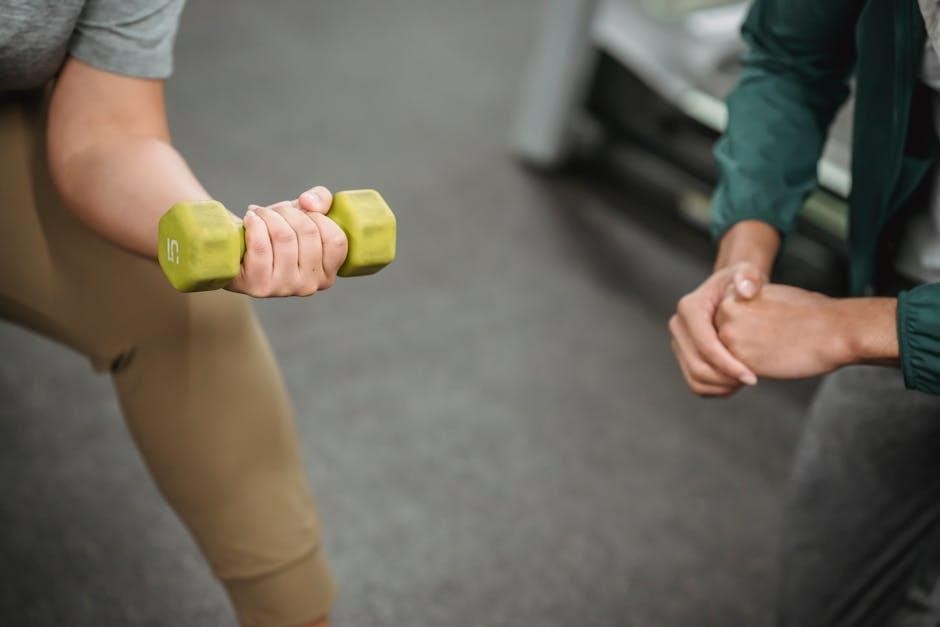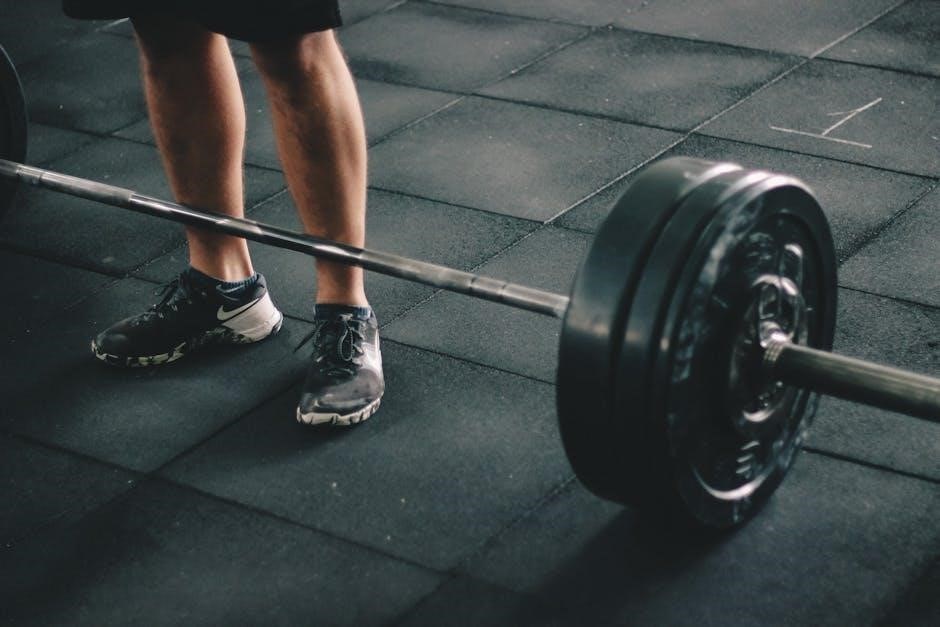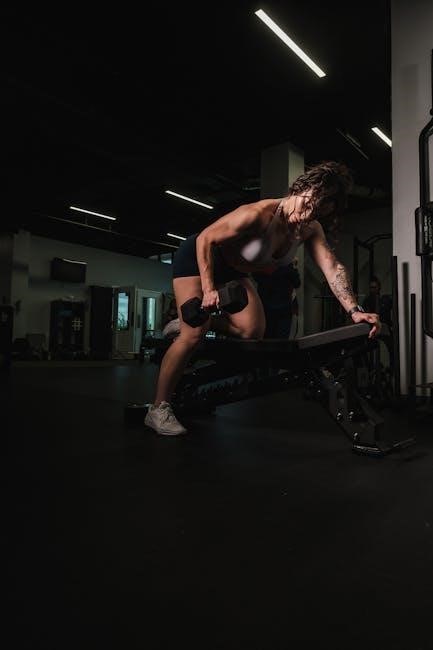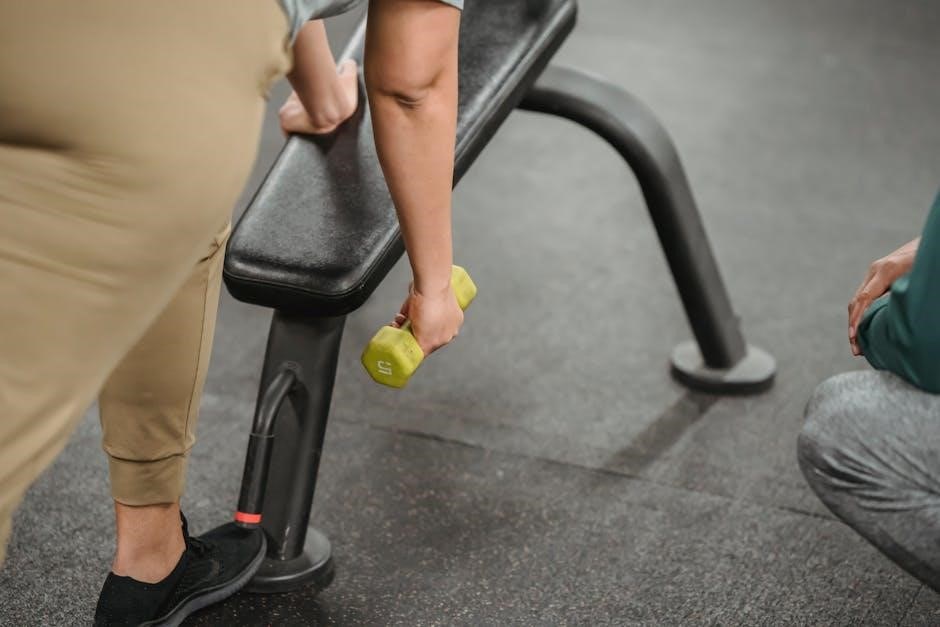A beginner dumbbell workout plan is an excellent starting point for building strength and muscle. Dumbbells are versatile, cost-effective, and allow for a full-body workout at home.
Why Dumbbells Are Ideal for Beginners
Dumbbells are perfect for beginners due to their simplicity and versatility. They allow for a full-body workout without requiring advanced equipment or gym access. Lightweight and easy to handle, dumbbells reduce the risk of injury compared to heavier weights. They also enable focus on proper form and technique, which is crucial for building strength safely. Additionally, dumbbells are cost-effective and space-efficient, making them ideal for home workouts. This accessibility makes them a great starting point for anyone new to weight training.
Benefits of a Structured Workout Plan for Beginners
A structured workout plan provides clarity and direction, helping beginners stay consistent and motivated. It ensures balanced training across all muscle groups, preventing overtraining and injury. By following a set routine, individuals can track progress and celebrate small achievements. A well-designed plan also saves time and effort, eliminating guesswork. This approach builds discipline and confidence, laying a strong foundation for long-term fitness success. It’s essential for beginners to follow a structured plan to maximize results and stay on track with their goals.

Choosing the Right Dumbbells for Beginners
Choosing the right dumbbells for beginners involves selecting 5-10 pound weights, considering adjustable options for versatility, and ensuring durability and comfort for safe and effective workouts.
Understanding Dumbbell Types: Adjustable vs. Fixed
When selecting dumbbells, beginners should consider whether adjustable or fixed weights suit their needs. Adjustable dumbbells allow for multiple weights in one set, saving space and cost. Fixed dumbbells, while less versatile, are often more durable and easier to handle. For those starting out, adjustable dumbbells are ideal as they offer flexibility to progress gradually. However, fixed dumbbells can provide a more stable and consistent workout experience. Both types are effective, so the choice depends on personal preference and training goals.
Starting Weights for Beginners: 5-10 Pounds
Beginners should start with lighter dumbbells, typically in the 5-10 pound range, to focus on proper form and technique. Using weights that are too heavy can lead to injury or poor execution. Lighter weights allow for muscle adaptation and strength building without strain. As strength increases, weights can gradually be increased. This approach ensures a safe and effective progression in the workout plan, helping to build a strong foundation for more advanced exercises in the future.
Setting Up Your Workout Structure
Beginners should train 3 times per week, alternating between upper and lower body workouts. This structure promotes balanced development and allows for adequate recovery between sessions.
How Often to Train: 3 Workouts Per Week
Training three times a week is ideal for beginners, allowing sufficient recovery time between sessions. This frequency helps build strength and endurance without overworking muscles. Experts suggest alternating between upper and lower body workouts to ensure balanced development. Consistency is key to seeing progress and avoiding plateaus. Over time, as strength increases, the intensity and frequency can gradually be adjusted to continue challenging the body effectively.
Splitting Workouts: Upper Body and Lower Body
Splitting workouts into upper and lower body sessions is an effective way to target specific muscle groups. This approach allows for focused training and adequate recovery. Beginners can alternate between upper body exercises like bench presses and rows, and lower body exercises such as squats and lunges. By dedicating separate days to each, you ensure balanced development and prevent overtraining. This structure also helps in maintaining consistency and progression in the workout plan, making it easier to track improvements over time.

Warm-Up Routine for Beginners
A proper warm-up includes dynamic stretching to improve flexibility and prevent injuries, along with light cardio to increase blood flow and prepare muscles for exercise.
Dynamic Stretching to Prevent Injury
Dynamic stretching is essential for preventing injuries and enhancing flexibility. It involves moving through a range of motions, such as arm circles, leg swings, and torso twists, to warm up muscles actively. This type of stretching improves blood flow and reduces muscle stiffness, making it ideal before a dumbbell workout. By incorporating dynamic stretches, beginners can prepare their bodies for exercise and lower the risk of strains or pulls. Consistency in this practice ensures better mobility and overall workout performance.
Light Cardio for Blood Flow
Light cardio is a crucial warm-up component that boosts blood flow and prepares the body for exercise. Activities like brisk walking, jogging, or cycling for 5-10 minutes increase heart rate and oxygen delivery to muscles. This helps prevent muscle soreness and enhances workout efficiency. Incorporating light cardio into a dumbbell routine ensures that beginners start their sessions with optimal physical readiness, reducing the risk of injury and improving overall performance. Consistent practice of this warm-up routine supports long-term fitness goals and muscle development.

Safety Tips for Dumbbell Workouts
Ensure dumbbells are free from damage and suitable for your fitness level. Always train with a partner for support and safety.
Proper Form to Avoid Injuries
Maintaining proper form is essential to prevent injuries during dumbbell exercises. Keep your core engaged and back straight to support your movements. Ensure full range of motion without sacrificing technique. Start with lighter weights to master each exercise, gradually increasing as strength improves. Focus on controlled movements, avoiding jerks or sways that can strain muscles or joints. Proper form ensures effectiveness and safety, allowing you to progress without setbacks.
Common Mistakes to Avoid
Common mistakes in a beginner dumbbell workout plan include using too much weight too soon, neglecting proper form, and overtraining. Avoid rounding your back during exercises like deadlifts, as this can lead to injury. Do not sacrifice technique for heavier weights or additional reps. Overtraining can hinder progress and cause muscle strain. Ensure adequate rest between sets and maintain consistent breathing to stay focused and maintain proper posture throughout each exercise.
Full-Body Dumbbell Workout Routine
This routine targets all major muscle groups with exercises like dumbbell squats and stiff-legged deadlifts, ensuring a balanced workout for beginners aiming to build overall strength and endurance.
Exercise 1: Dumbbell Squat (3 Sets of 10 Reps)
The dumbbell squat is a foundational exercise that works the legs, glutes, and core. Hold dumbbells at your sides or at shoulder height, then lower your body until your thighs are parallel to the floor. Keep your chest up and knees in line with your toes. Push through your heels to return to a standing position. This exercise improves lower-body strength and stability, making it a great starting point for beginners. Focus on maintaining proper form to maximize results and prevent injury.
Exercise 2: Dumbbell Stiff Legged Deadlift (3 Sets of 10 Reps)
The dumbbell stiff-legged deadlift targets the hamstrings, glutes, and lower back. Stand with feet shoulder-width apart, hold dumbbells in front of your thighs, and hinge at the hips to lower the weights toward the ground. Keep your knees slightly bent and back straight. Focus on squeezing your glutes at the top of the movement. This exercise improves posterior chain strength and posture. Start with lighter weights to master the form before increasing intensity.

Upper Body Dumbbell Workout
Target your chest, shoulders, and arms with effective dumbbell exercises. This workout focuses on building upper body strength and definition through exercises like bench presses and rows. Start light, progress gradually, and maintain proper form to prevent injuries and maximize results. Perfect for home workouts, these exercises improve posture and overall upper body functionality.
Exercise 3: Bent Over Dumbbell Row (3 Sets of 10 Reps)
The bent-over dumbbell row targets the back, shoulders, and arms. Stand with feet shoulder-width apart, hold dumbbells, and hinge at the hips. Keeping your back straight, lift the weights to your sides until elbows are at 90 degrees. Lower slowly to the starting position. This exercise improves posture and strengthens upper body muscles. Focus on controlled movements to avoid injury and maximize results. Ideal for beginners, it builds foundational strength effectively. Consistency is key for visible progress.
Exercise 4: Dumbbell Bench Press (3 Sets of 10 Reps)
The dumbbell bench press is a foundational exercise for chest development. Lie on a flat surface, hold dumbbells over your chest, and press upwards until arms are fully extended. Lower the weights to your chest, maintaining control throughout the movement. This exercise enhances chest muscles and improves overall upper body strength. Focus on proper form to prevent shoulder strain. Suitable for beginners, it’s an effective way to build a stronger chest and improve pressing power over time. Consistency yields noticeable results.

Lower Body Dumbbell Workout
A lower body dumbbell workout targets legs, glutes, and core. Exercises like goblet squats and rear lunges strengthen these areas effectively. Perfect for improving stability and overall lower body strength.
Exercise 5: Dumbbell Goblet Squat (4 Sets of 8-10 Reps)
The dumbbell goblet squat is an excellent exercise for lower body strength. Hold a dumbbell close to your chest with both hands, engage your core, and lower into a squat. Keep your back straight and knees over your toes. Push through your heels to return to the starting position. This exercise targets the quadriceps, hamstrings, and glutes, improving overall lower body stability and muscle development. Perform 4 sets of 8-10 reps for optimal results.
Exercise 6: Dumbbell Rear Lunge (4 Sets of 8-10 Reps)
The dumbbell rear lunge targets the hamstrings, glutes, and quads. Hold a dumbbell in one hand, step backward into a lunge, and lower until both knees are bent at 90 degrees. Keep your front knee behind your toes and your back knee nearly touching the floor. Push through your front heel to return to the starting position. This exercise improves balance, strength, and muscle development in the lower body. Perform 4 sets of 8-10 reps per leg for optimal results.

Core and Stability Exercises
Strengthen your core and improve stability with dumbbell exercises like planks, Russian twists, and bird dogs. These movements enhance posture, balance, and overall athleticism, essential for beginners.
Dumbbell Exercises for Core Strength
Strengthen your core with effective dumbbell exercises like planks, Russian twists, and bird dogs. These movements target your abs, obliques, and lower back, improving stability and balance. The Dumbbell Goblet Squat also engages the core, enhancing overall posture and athleticism. Perfect for beginners, these exercises require minimal equipment and can be done at home. Incorporate them into your routine to build a stronger, more stable foundation for other workouts. Consistency will yield noticeable improvements in core strength and overall fitness.

Progressing Your Workout Plan
Progressing your workout plan involves gradually increasing intensity, such as lifting heavier weights or adding reps, while maintaining proper form to prevent injuries and ensure steady improvement.
Increasing Weight Gradually
Gradually increasing weight is essential for muscle growth and strength. Start with 5-10 pounds and progress as your strength improves. Once you can complete the desired reps with ease, it’s time to increase the weight by small increments. Focus on maintaining proper form to avoid injuries. Allow your body to adapt to the new challenges, and always prioritize quality over quantity. This balanced approach ensures steady progress and helps prevent plateaus in your workout journey.
Adjusting Reps and Sets as You Get Stronger
As you progress, increase the number of reps or sets to continue challenging your muscles. Start with 3 sets of 10 reps and gradually move to 4-5 sets as strength improves. For upper body exercises, aim for 8-12 reps per set, while lower body exercises may require 10-15 reps. Adjusting reps and sets helps avoid plateaus and ensures consistent muscle growth. Focus on maintaining proper form and gradually increasing intensity to achieve long-term fitness goals effectively.

Nutrition and Recovery for Beginners
Proper nutrition and recovery are essential for muscle growth and overall health. Focus on protein-rich diets, balanced carbs, and healthy fats. Adequate rest and sleep aid muscle repair, while neglecting these can hinder progress. Combining these elements with consistent training yields the best results.
Importance of Protein for Muscle Growth
Protein is essential for muscle repair and growth, particularly after dumbbell workouts. Beginners should aim for 1.2-2.2 grams of protein per kilogram of body weight daily. Incorporate lean sources like chicken, fish, eggs, and plant-based options such as beans and tofu. Timing matters too—consume protein within an hour post-workout and distribute intake evenly throughout the day. Adequate protein intake supports recovery, helping muscles rebuild and strengthen, which is vital for progress in a beginner dumbbell workout plan.
Rest Days and Sleep for Recovery
Rest days and quality sleep are crucial for recovery in a beginner dumbbell workout plan. Muscles repair and grow during rest, not just during exercise. Aim for 7-9 hours of sleep nightly to support muscle recovery and overall performance. Poor sleep can hinder progress and increase injury risk. Incorporate rest days to allow muscles to rebuild, ensuring optimal gains and preventing overtraining. Consistent sleep and recovery routines are key to sustaining a successful workout plan and achieving long-term fitness goals.

Sample PDF Workout Plan
A downloadable 12-week dumbbell workout plan PDF provides a structured guide for beginners, offering exercise routines, sets, and reps to follow for consistent progress at home.
Downloadable 12-Week Dumbbell Workout Plan
This comprehensive PDF guide offers a structured 12-week program designed for beginners. It includes detailed exercise routines, specifying sets and reps for each workout. The plan progresses gradually, allowing users to build strength and muscle over time. Perfect for home workouts, it covers full-body exercises, upper body, lower body, and core workouts. The PDF is easy to follow, ensuring consistency and motivation throughout the 12-week journey. It’s ideal for those looking to transform their physique with minimal equipment.
Consistency and motivation are key to achieving success with a beginner dumbbell workout plan. Stay committed, track progress, and celebrate small victories to transform your physique effectively.
Staying Consistent and Motivated
Consistency and motivation are crucial for achieving success with a beginner dumbbell workout plan. Set realistic goals, track your progress, and celebrate small milestones to stay inspired. Create a routine that fits your lifestyle and holds you accountable. Having a workout buddy or joining a fitness community can also boost motivation. Remember, progress takes time, so focus on consistency rather than perfection. Stay committed, and with dedication, you’ll enjoy the transformative benefits of a healthier, stronger you.



